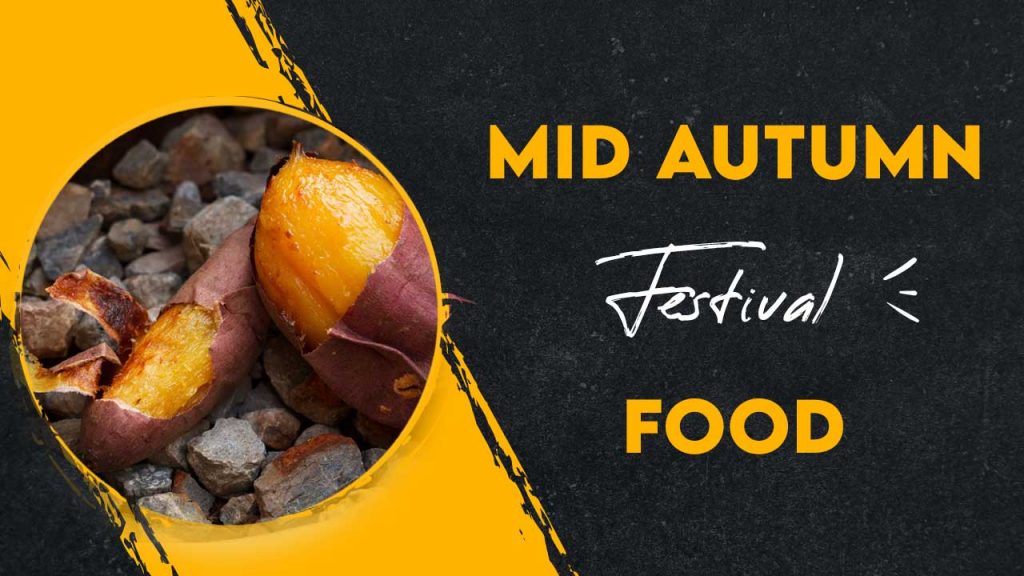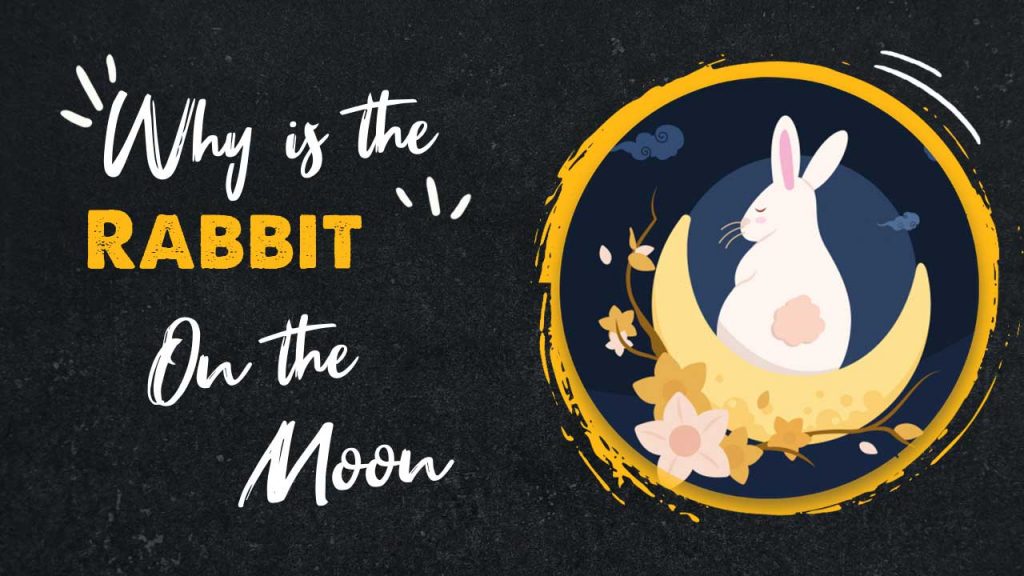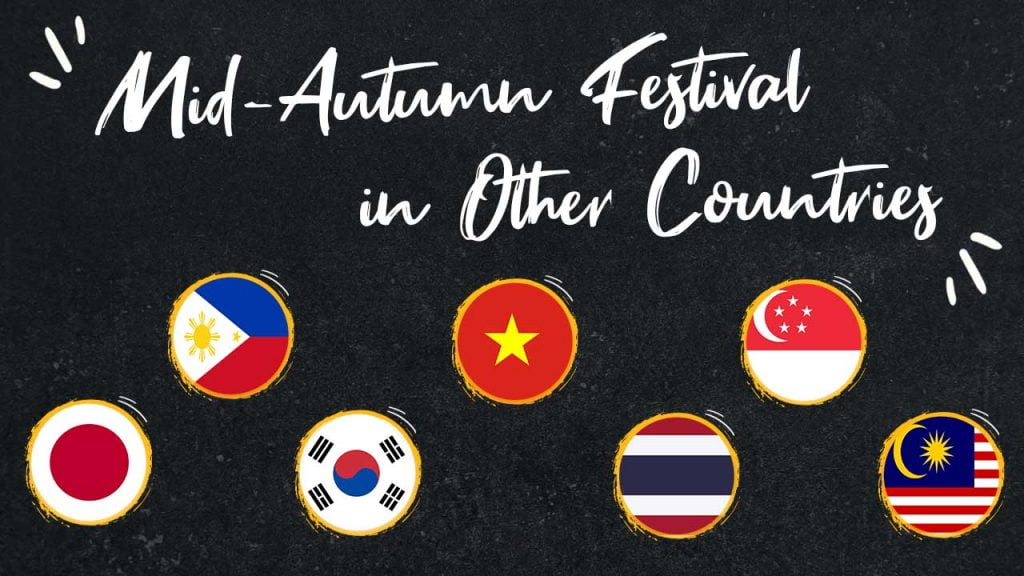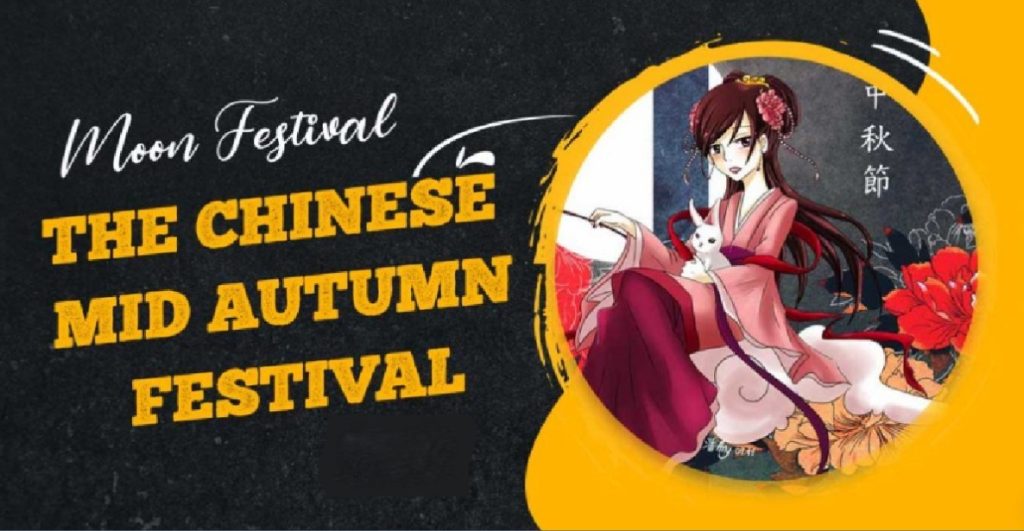Table of Contents
The Mid Autumn festival foods comprise a variety of stuff and Chinese people residing in different parts of the world consume them during this great festival time. No doubt, mooncakes are the prime delicacy for the Moon festival globally.
The Mid-Autumn Festival, also known as the Moon Festival, is the second biggest festival in China, after the Chinese New Year. It is celebrated on the 15th day of the 8th Lunar month when the moon is at its fullest and brightest. It is a time when the Chinese meet up with their families and reunite with their loved ones. The festival is synonymous with Thanksgiving, Praying, and Gathering.
Like most festivals, the moon festival food constitutes a major part of this celebration. Let us look at the different types of mid-autumn festival food items the Chinese enjoy during this occasion.
Mid Autumn Festival Foods List
Mooncakes 月饼
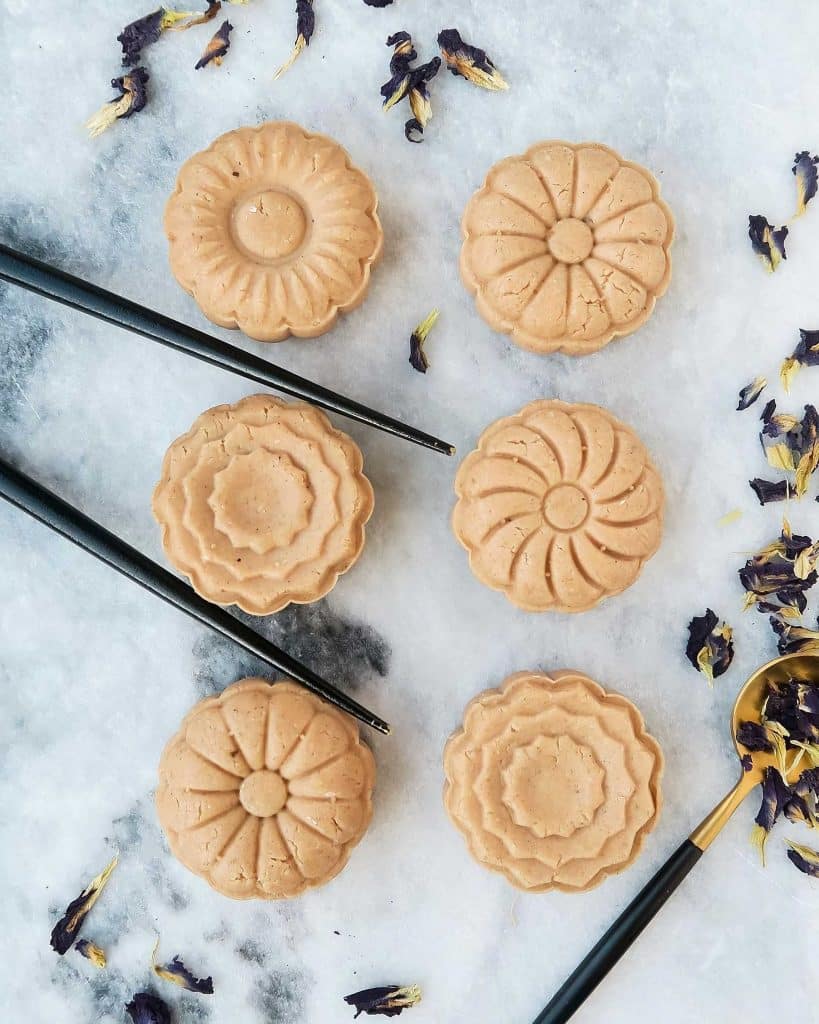

Mooncakes 月饼 are the most important part of the festival, along with the moon watching and appreciating the moon. In fact, the legend of the moon festival is incomplete without a mooncake.. So much so that Chinese Moon Festival foods are incomplete without mooncakes. The custom of eating mooncakes during the festival originated in the Yuan Dynasty (1279–1368). The Mongols ruled the dynasty, and it is also believed that messages to rebel against the Mongols were passed around in mooncakes. They were also used as an offering to the moon, and over the years, making and distributing this specialty became a trademark of this holiday.
In Chinese culture, roundness expresses completeness and togetherness. Hence, a full moon indicates prosperity and reunion for the whole family. Round mooncakes are very much like the harvest moon during the Mid-Autumn Festival. This pastry, sometimes sweet in flavor, is not just something the Chinese eat. It is a custom that signifies a spiritual feeling and one they follow religiously. As a part of the occasion, people eat mooncakes with their family. It is part of mid-autumn festival customs to give mooncakes to relatives or friends to show them love and best intentions. while wishing them a happy full moon festival.
The crust is made of vegetable oil or lard and is filled with red beans or lotus seed paste. Some even prepare mooncakes using other ingredients like chicken, duck, ham, pork, mushrooms, or egg yolks.
One important question would be, do mooncakes need to be refrigerated? Never, that makes it lose its flaky structure, unless, of course, it is ice-cream mooncake, in which case refrigerate immediately.
Osmanthus Cake 桂花蛋糕 and Osmanthus Wine 桂花酒
Osmanthus is a flower whose petals have a unique flavor that is only slightly bitter and very mildly sweet, making it ideal for cooking, making teas and wines, or as an ingredient for fragrance.
As the Song Dynasty Poet, Yang Wanli, once said, “Unlike other flowers smelling either too delicate or too intense, osmanthus presents a floral scent that is clean enough to wash away the dust in the air and rich enough to spread over miles. It’s hard to believe it comes from nature and not the moon in heaven.”
Osmanthus is a symbol of wealth and luck.
Osmanthus Cake 桂花蛋糕


Osmanthus Cake 桂花蛋糕 is a traditional mid-autumn festival food which is a sweet-scented Chinese pastry that originated in the Ming Dynasty (1368-1644). It is prepared with glutinous rice flour, honey sweet-scented osmanthus, and rock sugar. It is described as sweet and slightly translucent with soft and waxy characteristics.
It is a tradition for the Chinese to prepare these cakes as moon festival food. It is also when the osmanthus flower, native to East Asia, is in full bloom.
Osmanthus Wine 桂花酒

Osmanthus Wine 桂花酒 is a well-known Chinese wine and popular during the festival. It is produced from weak baijiu and flavored with sweet osmanthus flowers, making it mild and moderately sweet. Osmanthus is also said to extend one’s lifespan.
The wine is used as a ‘reunion wine’ and has less than 20% alcoholic content. It goes splendidly with mooncakes. Even in the Han Dynasty (206 BC-220 AD), osmanthus wine was a common item used to worship God and one’s ancestors. Following the function, a toast would be made to the elders with the wine, where the elderly would drink it for sound health and long life.
Hairy Crab 大闸蟹

Since the late 14th Century, the Hairy Crab 大闸蟹, also known as Mitten Crab, has been a delicacy thoroughly enjoyed during September and October. The crabs generally get ready to lay their eggs at this time of the year, and the Chinese say that this makes them tastier. While the crab has a cooling effect on one’s body, they are furthermore high in amino acids and protein.
The crabs are dipped in vinegar and ginger and accompanied by a glass of osmanthus wine for the feast. This Chinese autumn festival food item tastes amazing with soy sauce. Female crabs are more sought after in comparison to male crabs as they contain much more roe and are considered sweeter.
River Snails 河蜗牛

River Snails 河蜗牛 have been eaten by the people of China since the Qing Dynasty (1644–1912) and are a specialty of Guangzhou, where the tradition to eat it as an autumn festival food started. The snails are very meaty but must be cooked using strong herbs to overcome the odor of the dish. The dish is a must at every Mid-Autumn Festival as it is regarded that the snails bring a rich harvest, drive away adversity, and help improve one’s eyesight.
Duck 鸭

Duck 鸭 is a famous addition to the dining table during gatherings and has been followed for generations. Besides eating duck, giving a duck to family or friends is another practice followed in China. This originated from a secret signal of an uprising in the Yuan Dynasty (1271-1368) when the Han people could not stand the brutal ruling of the Mongolians anymore and decided to fight back. The Mongolians were called ‘Dazi,’ which sounded like ‘duck’ in Chinese. So that they were not exposed, they would use the code word ‘Eating Duck,’ which meant ‘Overthrow the Mongols.’ Even after the Yuan Dynasty was overthrown, this habit continued to be followed.
According to traditional Chinese Medicine, duck is supposed to be cooling, has multiple health benefits, and nourishes one’s body. It helps remove the heat from one’s body, helping to maintain the balance between Yin (cooling) and Yang (warming). Ducks are healthier at this time of the year and are considered both nutritious and delicious and hence have made their way into mid-autumn festival food traditions. The preparation changes from region to region, ranging from being cooked with TaroTaro, to Smoke Baked Duck, to a sweet-scented Osmanthus Duck, to Salted and Baked Duck.
Taro 芋头

Taro 芋头 is a root vegetable originally cultivated in Asia but is now enjoyed around the world. Its outer skin is brown with white flesh and purple specks all over. It has a mildly sweet taste and a texture similar to that of potato when cooked.
The tradition of eating TaroTaro began during the Qing Dynasty (1644–1912). The Jiangsu and Zhejiang dialects of Chinese ‘taro’ also sound like ‘luck is inside.’ Hence, eating TaroTaro drives away evil spirits, disasters, or misfortune and brings prosperity and wealth to the family throughout the year.
Taro, which is rich in fiber, potassium, magnesium, and Vitamin C and E, to name a few, can help improve one’s metabolism, control blood sugar levels, and reduce one’s risk of heart diseases. This healthy vegetable is consumed steamed, boiled, or baked and sometimes can be served as a dessert on the Chinese autumn festival food platter.
Taro is also a very famous delicacy in Japan along with moon rabbit mochi, which answers the question, do other countries celebrate the moon festival?
Pomegranate 石榴

The Chinese started eating PomegranatePomegranate 石榴 when the Chinese explorer, Zhang Qian, came back from Asia with this fruit. This fruit is considered very lucky. Having a large number of seeds, the fruit was indicative of a large number of children being born into the family. The shape and color denote happiness and unity. The Chinese even give a picture of a pomegranate at weddings or put a picture of Pomegranate in the house when they want more offspring. Hence, during this holiday, the Chinese, especially married women who have not conceived yet, eat the fruit and pray for children. Additionally, pomegranates are treated as a sacrifice to the moon to ask for long life, to be reunited with family, and for good fortune.
Pomelo 柚

Pomelo 柚 is harvested during the Mid-Autumn Festival and is one of the primary foods enjoyed by the Chinese. Considered a lucky fruit by the Chinese, it is sweet and sour to taste and has numerous health benefits.
In Mandarin, pomelos are called ‘you in. ‘You zi’ is a homophone for words that mean ‘prayer for a son.’ Thus, the fruit is consumed to pray for the young ones in the household. The festival is a time for thanksgiving, and this fruit is an autumn festival food offered to the Goddess of the Moon.
Pomelo has a high content of Vitamin C, is a powerful immunity booster, and can aid in preventing cellular damage.
Pumpkin 南瓜

In China, those from humble backgrounds who could not afford mooncakes would replace the same with pumpkins. After years of doing this, Pumpkin 南瓜 is automatically added to the list of foods eaten.
Legend has it that a girl staying with her sick parents stumbled over a pumpkin while working in the fields. She brought home the Pumpkin and fed it to her parents, who recovered miraculously. The Chinese name for Pumpkin means ‘South Melon’ as the girl picked it up from the South Mountain. It is consumed for good health and longevity.
Watermelon 西瓜

Like the Pomegranate, Watermelon 西瓜 seeds are symbolic of fertility. Its shape illustrates a reunion of family. In the Western Zhou Dynasty (1047 BC-770 BC), watermelons were an important part of ceremonies. They were carved in the shape of a Lotus since a Lotus is considered to be auspicious.
People have often tried out new shapes like rabbits, carp, or stars in recent times.
Lotus Roots 莲藕

Harvesting of the Lotus Root 莲藕 occurs around the Mid-Autumn Festival. Besides a slightly sweet and earthy taste, it has a crunchy texture when stir-fried. Lotus Roots have the necessary vitamins to keep one healthy, are low in calories, are high in fiber, and even help increase one’s appetite. Steamed Lotus Root with glutinous rice and honey represents a happy and charming life.
Pears 梨

Though the word for Pears 梨 sounds like the word for ‘separation’ and pears are avoided as gifts for joyous celebrations, eating pears during this time shows one’s desire to reunite with family. It is eaten to express that one does not wish to be separated from one’s relatives and is another fruit used to worship the moon. Osmanthus wine and pears make a great combination.
Buffalo Nut 菱角

Buffalo Nut 菱角 is otherwise known as water chestnut, bat nut, or the devil’s pod. Each fruit contains one very large seed. It is a unique plant, and the Chinese eat it hoping that their children will also grow up to be smart and unique. It can be eaten raw or boiled and used in other dishes like Pork Belly. It is another plant believed to bring well-being and fortune.
Walnuts 核桃 and Peanuts 花生


Walnuts 核桃 and Peanuts 花生 are round and auspicious looking, and the Chinese love to eat these nuts at gatherings and occasions. They can be eaten whole roasted or salted, and many love boiled peanuts. Walnuts are sometimes used as a filling for Mooncakes too.
Edamame 毛豆荚

Eating Edamame 毛豆荚 is a Southern Chinese observance as it sounds like ‘good news’ and ‘praise.’ Besides being had as a snack, it is used as an offering to the moon.
Over the years, many other fruits have been added to the table like apples, peaches, grapes, durian, star-fruits, and persimmons. Persimmons and apples signify that everything is going well, while peaches indicate a long life.
Mid Autumn Festival Food In Malaysia
Like the traditional mooncakes of China, Malaysia also has its local mooncakes like durian mooncakes, cubilose mooncakes, precious black mooncakes and emerald mooncakes. These are consumed during the Mid-Autumn Festival in Malaysia.
Besides handmade options, mooncakes are sold in supermarkets during the festival time. The snow skin mooncake is the most preferred mooncake flavor here. It is sweet and soft with durian filling.
Durian flesh stuffing is creamy, which tastes better after being frozen. Snow skin mooncakes as the Mid Autumn Festival food is generally priced higher than other types.
Baker’s Cottage, Oversea, Kam Lun Tai, Tai Thong, Fah San are some of the prominent brand names for mooncakes in Malaysia.
Mid-Autumn Festival Food Singapore
Undoubtedly, mooncakes are a prominent food of the Mid-Autumn Festival in Singapore too.
Singaporeans prefer mooncakes that are different from their Chinese version. They eat durian-filled mooncakes, which are also the most native mooncakes to Singapore.
Today, a variety of mooncakes will be consumed in Singapore during the mid-autumn moon festival 2022 besides the traditional ones. The traditional flavors with lotus seed paste and egg yolk are somehow replaced with snow skin versions. And, their fillings vary from chocolate to champagne truffle.
People enjoy mooncakes with a strong, palate-cleansing cup of Chinese tea in Singapore as special food for the moon festival.
Also, the Celebration of Mid Autumn festival in Philippines is renowned worldwide.

